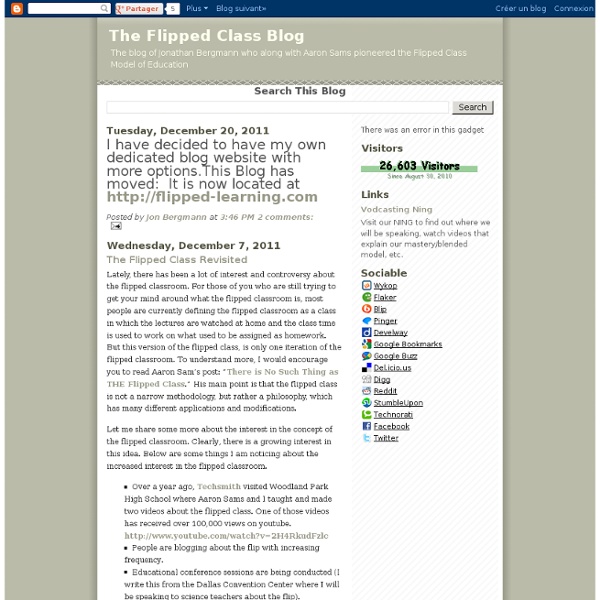



The Flipped Classroom Model: A Full Picture Due to Khan Academy’s popularity, the idea of the flipped classroom has gained press and credibility within education circles. Briefly, the Flipped Classroom as described by Jonathan Martin is: Flip your instruction so that students watch and listen to your lectures… for homework, and then use your precious class-time for what previously, often, was done in homework: tackling difficult problems, working in groups, researching, collaborating, crafting and creating. A compiled resource page of the Flipped Classroom (with videos and links) can be found at The advantage of the flipped classroom is that the content, often the theoretical/lecture-based component of the lesson, becomes more easily accessed and controlled by the learner. It is important, though, not to be seduced by the messenger. The problem is that educators, as a group, know how to do and use the lecture. The Flipped Classroom Model Experiential Engagement: The Activity Summary
ThomsonScience | Ramblings about my life as a chemistry teacher Flipping the classroom. It's time. For years I've been talking about how online learning creates a "reversal of fortune," because in a classroom the student is entirely on the teacher's turf, but as soon as you put learning online it's the opposite. It's the teacher and the learning that has to adapt to the student's personal environment. This reversal has enormous ramifications, the top of the heap being that online learning must now be considered a product in ways the classroom does not. You can't assume learners will follow your rules just because you say so. The reversal of fortune has now evolved, and its offspring is the flipped classroom. is, at its most basic, asking students to learn the content at home and practice it in the classroom, instead of the other way around. Pearson has been flipping the classroom with its MyMathLab product for years, though sometimes without the knowledge of the faculty. So how does this relate to the online learning "reversal of fortune?" What does all this mean?
eSchool News TV K-12 Digital World Language Courses Immerse Students in Language & Culture Middlebury Interactive’s digital world language courses—from kindergarten through high school and Advanced Placement—utilize principles of the immersion pedagogy and teaching methodology of Middlebury College’s famed Language Schools. Courses… TechSmith in Education See how instructors across the country use TechSmith solutions to enhance learning. Evergreen Schools Case Study: How Online Learning Serves a Diverse Student Population Evergreen Public Schools in Vancouver, WA, serves more than 26,000 students and is one of the fastest-growing school districts in the state. Deliver the Bilingual Advantage Preparing today’s students with 21st Century skills increasingly includes language. TabPilot Android Tablet Management for Schools TabPilot is a cloud-based management system that puts teachers in control of classroom tablets. Teachers get more teaching time Teachers waste less time waiting Kids stay learning longer
I spy with my #flipclass eye…Is texting the problem? | flipperteach Can I be honest? I wrote and passed notes in class my entire high school career. I even collected said notes and displayed them in shoe box with pride. “Look! This is what I have accomplished!”. Did this extensive social note writing hinder my education? In fact, at times the entire class participated in social note writing, and notes would pass around and be added to throughout class. Communicating as I learn is how I put pieces of the puzzle together. As an adult, I now know that with my own learning, communication always leads to engagement. This year as I transitioned from being a “stand and deliver” teacher to one where I am more a “guide on the side” in the flipped classroom, I gained time to interact with and observe students in an insightful way. When I see it happen, I know: “Yup, I went the wrong way, turn around and find your way back to the heart of the matter.” Students need to be engaged. In our flip classroom cell phones/technology are welcome in class. P.S. Like this:
Flipped classroom - no more It seemed like a good idea. It worked for a while. How do I know? Then it didn't work anymore. The test results were horrible. Even though it's disappointing that the flipped classroom strategy didn't work, I'm happy we tried it. Afterwards, I talked at length about why we tried flipped classroom (to get more time for problem solving / exercises in class because the students were not doing them at home). 12 Screencasting Tools For Creating Video Tutorials Ever wondered how people show you so clearly what is happening on their computer, like in the Photoshop Video Tutorials we shared with you? Thanks to screencasting software, anyone can do it. So what's stopping you now from making your own how-to videos? Free AviScreen - As the name would imply, this capture program records the video into AVI files, but can also do BMP photos. CamStudio.org - An open source program for capturing your on-screen video and audio as AVI files. Copernicus - A free program for Macs that focuses heavily on making quick and speedy films by recording the video to your RAM for quicker access. JingProject.com - Beyond recording video, Jing allows you to take a picture of any portion fo your desktop, draw on it, add a message, and immediately upload your media to a free hosting account. Screencast-O-Matic.com - A Java-based screencasting tool that requires no downloads and will allow you to automatically upload to hosting. Commercial
Flipping with Kirch Inverting the classroom, improving student learning